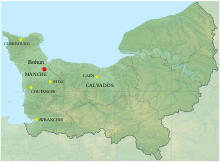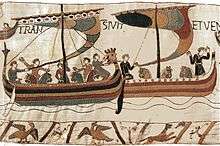Humphrey with the Beard
Humphrey de Bohun, called "With the Beard", (died before 1113) was a Norman soldier and nobleman, the earliest known ancestor of the English de Bohun family, later prominent as Earls of Hereford and Earls of Essex. The last in the senior male line of his descendants was Humphrey de Bohun, 7th Earl of Hereford (1341-1373) who left two daughters and co-heiresses, Eleanor de Bohun (c.1366-1399) the wife of Thomas of Woodstock, 1st Duke of Gloucester, the youngest child of King Edward III; and Mary de Bohun (c.1369/70-1394) the first wife of King Henry IV and the mother of King Henry V.

Epithet

His epithet, "With the Beard" (Latin: cum barba), was a distinguishing one in eleventh-century Normandy, where the custom was to shave the face and back of the head. It is first recorded in a later chronicle of Llanthony Prima, transcribed by William Dugdale in his Monasticon Anglicanum (VI.134):
- Dominus Humfredus de Bohun, cum barba, qui prius venit cum Willielmo Conquestore in Angliam de Normannia, cognatus dicti Conquestoris. . . ("Lord Humphrey de Bohun, with the beard, who first came with William the Conqueror to England from Normandy, a relative of the said Conqueror").[1]
Origins
As is stated by Wace (d.1174) in his Roman de Rou, Humphrey originated at the manor of "Bohun" in Normandy: De Bohun le Vieil Onfrei ("from Bohun the old Humphrey").[2] Today this territory comprises two communes, Saint-André-de-Bohon and Saint-Georges-de-Bohon, situated 26 km north-east of Coutances and 18 km north-west of Saint-Lô.
Career
He donated a plough and garden to the nuns of the Abbaye Saint-Amand at Rouen, Normandy. The charter was witnessed by William, Duke of Normandy as Comes ("Count") rather than Rex ("king"), thus placing the gift before the 1066 Norman Conquest of England. He later donated the church of Saint-Georges-de-Bohon to the Abbey of Marmoutier near Tours in the Kingdom of France. After the Conquest, he was granted lands in England including his seat at the manor of Tatterford in Norfolk, as recorded in the Domesday Book of 1086.
Marriages and children
The charters confirming his donation to the Abbaye Saint-Amand indicate that he had married three times, but the names of his wives are unknown. He had three sons and two daughters, including:
- Robert de Bohun, eldest son, who died unmarried and predeceased his father.
- Richard de Bohun, 2nd son, and progenitor via a female line of the Bohuns of Midhurst.
- Humphrey I de Bohun (died c.1123), youngest son, who by convention (according to Planché) is given the first ordinal number because by his lucrative marriage he was "the founder of the fortunes of his family".[3]
Sources
- Graeme White, "Bohun, Humphrey (III) de (b. before 1144, d. 1181)," Oxford Dictionary of National Biography, Oxford University Press, 2004, accessed 20 December 2009.
References
- Melville M. Bigelow, "The Bohun Wills," American Historical Review, 1:3 (1896), 414–15.
- Planche, quoting Roman de Rou, line 13,583
- J. R. Planché, The Conqueror and his Companions (London, 1874), II, 63–66.